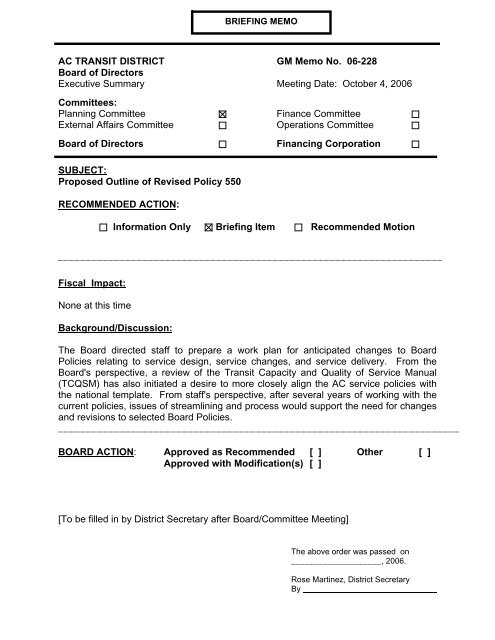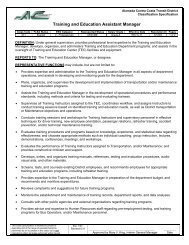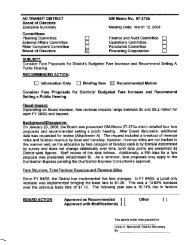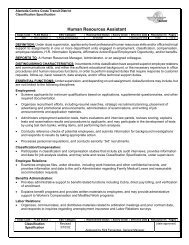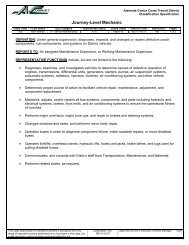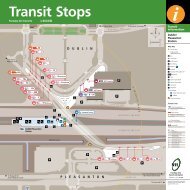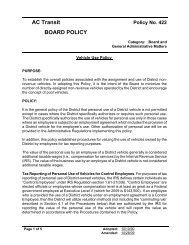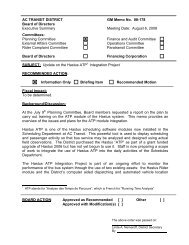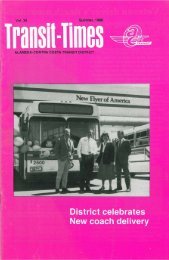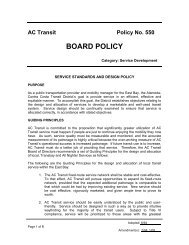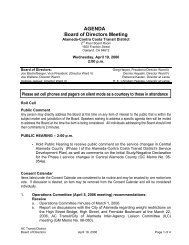AC TRANSIT DISTRICT GM Memo No. 06-228 Board of Directors ...
AC TRANSIT DISTRICT GM Memo No. 06-228 Board of Directors ...
AC TRANSIT DISTRICT GM Memo No. 06-228 Board of Directors ...
You also want an ePaper? Increase the reach of your titles
YUMPU automatically turns print PDFs into web optimized ePapers that Google loves.
BRIEFING MEMO<br />
<strong>AC</strong> <strong>TRANSIT</strong> <strong>DISTRICT</strong> <strong>GM</strong> <strong>Memo</strong> <strong>No</strong>. <strong>06</strong>-<strong>228</strong><br />
<strong>Board</strong> <strong>of</strong> <strong>Directors</strong><br />
Executive Summary Meeting Date: October 4, 20<strong>06</strong><br />
Committees:<br />
Planning Committee<br />
External Affairs Committee<br />
<strong>Board</strong> <strong>of</strong> <strong>Directors</strong><br />
Finance Committee<br />
Operations Committee<br />
Financing Corporation<br />
SUBJECT:<br />
Proposed Outline <strong>of</strong> Revised Policy 550<br />
RECOMMENDED <strong>AC</strong>TION:<br />
Information Only Briefing Item Recommended Motion<br />
Fiscal Impact:<br />
<strong>No</strong>ne at this time<br />
Background/Discussion:<br />
The <strong>Board</strong> directed staff to prepare a work plan for anticipated changes to <strong>Board</strong><br />
Policies relating to service design, service changes, and service delivery. From the<br />
<strong>Board</strong>'s perspective, a review <strong>of</strong> the Transit Capacity and Quality <strong>of</strong> Service Manual<br />
(TCQSM) has also initiated a desire to more closely align the <strong>AC</strong> service policies with<br />
the national template. From staff's perspective, after several years <strong>of</strong> working with the<br />
current policies, issues <strong>of</strong> streamlining and process would support the need for changes<br />
and revisions to selected <strong>Board</strong> Policies.<br />
BOARD <strong>AC</strong>TION: Approved as Recommended [ ] Other [ ]<br />
Approved with Modification(s) [ ]<br />
[To be filled in by District Secretary after <strong>Board</strong>/Committee Meeting]<br />
The above order was passed on<br />
____________________, 20<strong>06</strong>.<br />
Rose Martinez, District Secretary<br />
By
<strong>GM</strong> <strong>Memo</strong> <strong>No</strong>. <strong>06</strong>-<strong>228</strong><br />
Subject: Proposed Outline <strong>of</strong> Revised Policy 550<br />
Date: October 4, 20<strong>06</strong><br />
Page 2 <strong>of</strong> 12<br />
This memorandum provides an outline <strong>of</strong> the structure <strong>of</strong> a revised <strong>Board</strong> Policy 550,<br />
and a discussion <strong>of</strong> the associated policy issues. It does not deal with the approval<br />
and public hearing process, which will be the subject <strong>of</strong> a separate analysis.<br />
Guiding Principles<br />
Since the <strong>Board</strong>’s consideration <strong>of</strong> the Service Deployment Policies in 2000, a series <strong>of</strong><br />
“Guiding Principles” has governed the design <strong>of</strong> transit routes and the development <strong>of</strong> a<br />
hierarchy <strong>of</strong> funding priorities. These principles provide a reasonably comprehensive<br />
“blueprint” for the function and design <strong>of</strong> the local transit system, but they did not<br />
address Transbay service or the All-Nighter network. Staff recommends the <strong>Board</strong><br />
adopt revised Guiding Principles that cover these specialized services.<br />
With reference to a revised Policy 550, staff recommends the following text for the<br />
section on Guiding Principles (changes from the most recently amended Policy are in<br />
bold italics):<br />
The following are the Guiding Principles for the design and allocation <strong>of</strong> local transit<br />
service within the East Bay:<br />
1. <strong>AC</strong> Transit, working with other transit operators in its service area,<br />
will increase annual per capita transit trips within the <strong>AC</strong> Transit<br />
service area (in the East Bay) to 100 by 2010.<br />
2. <strong>AC</strong> Transit will not only act as a provider <strong>of</strong> a social good, but an<br />
aggressive instigator <strong>of</strong> service, and an overall mobility manager for<br />
the East Bay.<br />
3. <strong>AC</strong> Transit will develop a straightforward and marketable transit<br />
system, one that is easily understood by the public and easy to use.<br />
<strong>AC</strong> Transit services will operate frequently enough so that<br />
passengers do not need a schedule to use the system on a large<br />
part <strong>of</strong> the service. The most well patronized routes will feature<br />
faster limited stop services to decrease overall travel times.<br />
<strong>AC</strong> Transit’s transit network will provide for a multidestinational<br />
system that serves all major traffic generators<br />
throughout the East Bay regardless <strong>of</strong> location, operating<br />
along a grid <strong>of</strong> routes in the densest portions <strong>of</strong> the service<br />
area with route spacing <strong>of</strong> about 1000 meters, or approximately<br />
six-tenths <strong>of</strong> a mile.<br />
4. <strong>AC</strong> Transit will be the lead transportation agency as the central East<br />
Bay core cities increase density, leading to more demands for<br />
transit services. <strong>AC</strong> Transit will support these smart growth and in-
<strong>GM</strong> <strong>Memo</strong> <strong>No</strong>. <strong>06</strong>-<strong>228</strong><br />
Subject: Proposed Outline <strong>of</strong> Revised Policy 550<br />
Date: October 4, 20<strong>06</strong><br />
Page 3 <strong>of</strong> 12<br />
fill efforts by designing routes and services to meet this new<br />
demand.<br />
5. <strong>AC</strong> Transit will aggressively pursue transit priority and transit<br />
preferential measures at the most important locations to improve<br />
street operation <strong>of</strong> the transit system, to decrease transit passenger<br />
travel times, to improve reliability, and to reduce overall system<br />
operating cost.<br />
6. The transit system should be seamless to the passenger<br />
regardless <strong>of</strong> the operator. Services, transfers and fares should be<br />
transparent to the passenger.<br />
7. The transit system route network will allow for modal conversions,<br />
when and if those are appropriate, and the service planning effort<br />
should complement the District’s other planning work.<br />
8. Transit service should be prioritized to those areas with the<br />
greatest potential for transit use, subject to Title VI compliance,<br />
with good patronage rewarded by better service and shorter<br />
passenger waits.<br />
The following are the Guiding Principles for the design and allocation <strong>of</strong> transit<br />
service within Transbay Corridors:<br />
1. <strong>AC</strong> Transit will provide and facilitate all-day Transbay bus services in<br />
areas that are not well served by, or distant from, regional rail services.<br />
2. <strong>AC</strong> Transit will provide or facilitate weekday peak period Transbay bus<br />
service in order to provide a supplement to capacity constrained<br />
regional rail services, specifically within corridors where rail capacity is<br />
limited.<br />
3. <strong>AC</strong> Transit will provide a “many-to-one” service pattern from dense<br />
areas <strong>of</strong> the East Bay to downtown San Francisco, primarily developing<br />
a Transbay transit system that encourages walk access to transit, but<br />
may facilitate automobile park and ride access in low density areas and<br />
for Transbay transit access in the San Mateo and Dumbarton Bridge<br />
corridors.<br />
4. Transbay Services will be funded from passenger fares and regional<br />
sources, most appropriately those revenue sources derived from users<br />
<strong>of</strong> the bridge corridors who benefit from decreased highway and bridge<br />
congestion. The District will support legislation to identify and<br />
implement these non-general fund sources.
<strong>GM</strong> <strong>Memo</strong> <strong>No</strong>. <strong>06</strong>-<strong>228</strong><br />
Subject: Proposed Outline <strong>of</strong> Revised Policy 550<br />
Date: October 4, 20<strong>06</strong><br />
Page 4 <strong>of</strong> 12<br />
The following are the Guiding Principles for the design and allocation <strong>of</strong> transit<br />
service in All-Nighter (Owl) Corridors:<br />
1. All-Nighter services are part <strong>of</strong> a regional network, and the All-Nighter<br />
route network should conform to the existing regional network,<br />
including the regional rail system and the trunk bus network.<br />
2. All-Nighter services will be funded from regional sources, most<br />
appropriately those revenue sources derived from users <strong>of</strong> the bridge<br />
corridors who benefit from decreased highway and bridge congestion<br />
and funding, ensuring access to employment. The District will support<br />
legislation to identify and implement these non-general fund sources.<br />
Service Design Metrics<br />
The following section provides text and discussion regarding Service Design Metrics, for<br />
potential inclusion in revised <strong>Board</strong> Policy 550.<br />
Staff presents for <strong>Board</strong> consideration the recommendation to apply Level-<strong>of</strong>-Service<br />
(LOS) standards to service design and delivery. The TCQSM presents multiple indices<br />
<strong>of</strong> both service design criteria and service delivery standards that focus on the<br />
passenger’s point <strong>of</strong> view.<br />
LOS metrics were originally developed in 1965 as part <strong>of</strong> the Highway Capacity Manual.<br />
The rating system is familiar to transportation policymakers, especially as it relates to<br />
roadway conditions. Briefly, values for specific performance measures are divided into<br />
6 ranges, with each assigned a ranking from A (best) to F (worst). It is important to note<br />
that these rankings are from the customer's perspective, and do not necessarily<br />
represent the transit provider's point <strong>of</strong> view, nor acknowledge the transit provider’s<br />
operational or financial constraints. The following represent the A to F ratings for<br />
Service Provision, Travel Time, Load Factor and Service Span:<br />
Figure 1: Service Provision<br />
LOS Average Comments<br />
Headway<br />
A 60 Service unattractive to all riders
<strong>GM</strong> <strong>Memo</strong> <strong>No</strong>. <strong>06</strong>-<strong>228</strong><br />
Subject: Proposed Outline <strong>of</strong> Revised Policy 550<br />
Date: October 4, 20<strong>06</strong><br />
Page 5 <strong>of</strong> 12<br />
Figure 2: Travel Time<br />
LOS Travel Time Comments<br />
Difference<br />
(min)<br />
A 0 Faster by transit than by automobile<br />
B 1--15 About as fast by transit as by automobile<br />
C 16--30 Tolerable for choice riders<br />
D 31--45 Round-trip at least an hour longer by transit<br />
E 46--60 Tedious for all riders; may be best possible in small cities<br />
F >60 Unacceptable for most riders<br />
Figure 3: Load Factor<br />
LOS Load Factor Comments<br />
(pax/seat)<br />
A 0.00--0.50 <strong>No</strong> passenger need sit next to another<br />
B 0.51--0.75 Passengers can choose where to sit<br />
C 0.76--1.00 All passengers can sit<br />
D 1.01--1.25 Comfortable standee load for design<br />
E 1.26--1.50 Maximum Schedule Load<br />
F >1.50 Crush load<br />
Figure 4: Service Span<br />
LOS Span <strong>of</strong> Comments<br />
Service<br />
A 19-24 hours Night or Owl service provided<br />
B 17-18 Late evening service provided<br />
C 14-16 Early evening service provided<br />
D 12-13 Daytime service provided<br />
E 4-11 Peak hour only service or limited weekday service<br />
F 0-3 Very limited or no service<br />
Balancing against Design Metrics are Performance Metrics, which are also included for<br />
the <strong>Board</strong>’s consideration. These Performance Metrics acknowledge that resources are<br />
limited and, consistent with Guiding Principle 8, recommend that high patronage should
<strong>GM</strong> <strong>Memo</strong> <strong>No</strong>. <strong>06</strong>-<strong>228</strong><br />
Subject: Proposed Outline <strong>of</strong> Revised Policy 550<br />
Date: October 4, 20<strong>06</strong><br />
Page 6 <strong>of</strong> 12<br />
be rewarded with better service, while low ridership would result in recommendations for<br />
decreases in service.<br />
Overall System Metric – The TCQSM provides guidance on the overall system<br />
aspirations. For example, the Manual discusses the concept <strong>of</strong> "Transit Supportive<br />
Areas" (TSA's), geographical areas that from a passenger point-<strong>of</strong>-view could<br />
reasonably have transit service. TSA's are more conducive to transit use than other<br />
areas for reasons relating to household or employment density, street patterns, traffic<br />
generators, and other factors.<br />
Within the <strong>AC</strong> Transit District, the TSA is generally defined as Berkeley to San Leandro,<br />
with an additional TSA along the major corridors extending from this core area. <strong>AC</strong><br />
Transit will seek to provide transit service within one quarter <strong>of</strong> a mile for 80 to 89.9<br />
percent <strong>of</strong> the geographic area <strong>of</strong> the TSA. This service allocation corresponds to LOS<br />
B. Within this TSA, <strong>AC</strong> Transit will provide service that meets further service design<br />
criteria, which are listed below.<br />
Current <strong>Board</strong> Policy 550 provides density standards and service objectives. A chart<br />
provided as an attachment to the Policy references an expected farebox recovery range<br />
<strong>of</strong> 20% for Low Density areas, 25% for Suburban routes, and 40% for Trunk and Major<br />
Corridor routes. As was reported to the <strong>Board</strong> in January, only 4 routes met the<br />
anticipated farebox recovery in 2005 (<strong>GM</strong> <strong>Memo</strong> <strong>06</strong>-013). However, most routes met<br />
the minimum passengers per hour threshold as identified in the current <strong>Board</strong> Policy.<br />
Specialized services, such as Transbay and All-Nighter, have individual performance<br />
requirements. Regional Measure 2 (RM2) guidelines allow for a 3 year "ramping up"<br />
period to meet the required farebox recovery standard.<br />
For inclusion in revised <strong>Board</strong> Policy 550, staff has provided updated descriptions <strong>of</strong><br />
the various services operated by <strong>AC</strong> Transit. Each <strong>of</strong> the following categories<br />
represents a distinct service type:<br />
• Trunk Routes and Major Corridors<br />
• Urban Secondary, Crosstowns and Feeder Routes<br />
• Suburban Crosstowns and Feeder Routes<br />
• Low Density Routes<br />
• Community Services/Circulators<br />
• All-Nighter Routes<br />
• Transbay Service<br />
• Supplemental Service<br />
Trunk Routes and Major Corridors – These are the services operating on corridors<br />
where residential densities are at least 20,000 residents per square mile.
<strong>GM</strong> <strong>Memo</strong> <strong>No</strong>. <strong>06</strong>-<strong>228</strong><br />
Subject: Proposed Outline <strong>of</strong> Revised Policy 550<br />
Date: October 4, 20<strong>06</strong><br />
Page 7 <strong>of</strong> 12<br />
• BRT and Capital Investment Triggers – <strong>AC</strong> Transit would consider implementing<br />
Stage 1 and 2 BRT in Major Corridors where warranted by transit ridership, and<br />
where there is sufficient opportunity to create a faster and more frequent service.<br />
• Target Service Guidelines – Corridor service in areas below 20,000 residents per<br />
square mile will have a target <strong>of</strong> LOS B (service frequencies <strong>of</strong> every 10-15<br />
minutes) and a targeted service span <strong>of</strong> LOS B (17-18 hours <strong>of</strong> service daily).<br />
Corridors where densities are greater than the 20,000 threshold will have a target<br />
<strong>of</strong> LOS A ( service frequencies <strong>of</strong> 10 minutes or better) and a targeted service<br />
span <strong>of</strong> LOS A (19-24 hours).<br />
• Target Travel Time is recommended at LOS B (not more than 15 minutes longer<br />
than an automobile trip) and load factors <strong>of</strong> not greater than 1.25 (LOS D) are<br />
recommended.<br />
• Target Performance Criteria – Transit services in the Trunk Route and Major<br />
Corridor category are judged on a corridor segment basis, not on a transit route<br />
basis. Major Corridor services have a target <strong>of</strong> at least 40 passengers per inservice<br />
hour weekdays. Failure to perform at this level will drop the Corridor or<br />
corridor segment to a “Secondary” Corridor.<br />
• Funding Hierarchy – Major Corridor services have the highest priority for District<br />
resources, in order to maximize planned capital investments.<br />
Urban Secondary, Crosstowns and Feeder Routes – These are the routes remaining<br />
after the Corridor routes within the TSA.<br />
• Target Service Guidelines – Secondary, Crosstown and Feeder Routes will have<br />
a service frequency target <strong>of</strong> LOS C (service frequencies <strong>of</strong> every 15 – 20<br />
minutes) and a targeted service span <strong>of</strong> LOS C (14-16 hours <strong>of</strong> service daily).<br />
To the extent practicable, service will be operated with clock headways (i.e.,<br />
headways are evenly divisible into 60).<br />
• Target Travel Time is recommended at LOS C (not more than 30 minutes longer<br />
than an automobile trip), and load factors <strong>of</strong> not greater than 1.25 (LOS D) are<br />
recommended.<br />
• Target Performance Criteria – Transit services in the Secondary, Crosstown and<br />
Feeder category are judged on a corridor segment basis, not on a transit route<br />
basis. Secondary, Crosstown and Feeder Route services have a target <strong>of</strong> at<br />
least 25 passengers per in-service hour weekdays. Failure to perform at this<br />
level will result in consideration <strong>of</strong> service discontinuance.
<strong>GM</strong> <strong>Memo</strong> <strong>No</strong>. <strong>06</strong>-<strong>228</strong><br />
Subject: Proposed Outline <strong>of</strong> Revised Policy 550<br />
Date: October 4, 20<strong>06</strong><br />
Page 8 <strong>of</strong> 12<br />
• Funding Hierarchy – Secondary, Crosstown and Feeder Routes follow Corridor<br />
services in funding priority for District resources.<br />
Suburban Crosstowns and Feeder Routes – These are the routes that do not reside<br />
completely with the TSA, but are adjacent to it and either some portion <strong>of</strong> the route is<br />
operated within the TSA, or it is connected with services that do operate within the<br />
TSA.<br />
• Target Service Guidelines – Suburban Crosstowns and Feeder Routes will have<br />
a service frequency target <strong>of</strong> LOS D (service frequencies <strong>of</strong> every 30 minutes or<br />
better) and a targeted service span <strong>of</strong> LOS C (14-16 hours <strong>of</strong> service daily). To<br />
the extent practicable, service will be operated with clock headways. Timed<br />
transfers will be employed.<br />
• Target Travel Time is recommended at LOS C (not more than 30 minutes longer<br />
than an automobile trip) and load factors <strong>of</strong> not greater than 1.25 (LOS D) are<br />
recommended.<br />
• Target Performance Criteria – Suburban Crosstowns and Feeder Route services<br />
have a target <strong>of</strong> at least 20 passengers per in-service hour weekdays. Failure to<br />
perform at this level will result in consideration <strong>of</strong> service discontinuance. Transit<br />
services in the Suburban Crosstowns and Feeder category are judged on a<br />
transit route basis.<br />
• Funding Hierarchy – Suburban Crosstowns and Feeder Routes follow Crosstown<br />
and Feeder Routes services in funding priority for District resources.<br />
Low Density Routes– These are primarily routes that reside in areas with less than<br />
5,000 residents per square mile. Most <strong>of</strong> this area is within Special Transit District 2.<br />
• Target Service Guidelines – Low Density Routes will have a service frequency<br />
target <strong>of</strong> LOS E (service frequencies <strong>of</strong> every 60 minutes or better) and a<br />
targeted service span <strong>of</strong> LOS C (14-16 hours <strong>of</strong> service daily). To the extent<br />
practicable, service will be operated with clock headways. Timed transfers will<br />
be employed.<br />
• Target Travel Time is recommended at LOS C (not more than 30 minutes longer<br />
than an automobile trip) and load factors <strong>of</strong> not greater than 1.25 (LOS D) are<br />
recommended.<br />
• Target Performance Criteria – <strong>No</strong> Standard, but service within the category will<br />
be judged relative to other transit lines within the same category.
<strong>GM</strong> <strong>Memo</strong> <strong>No</strong>. <strong>06</strong>-<strong>228</strong><br />
Subject: Proposed Outline <strong>of</strong> Revised Policy 550<br />
Date: October 4, 20<strong>06</strong><br />
Page 9 <strong>of</strong> 12<br />
• Funding Hierarchy – Low Density Routes are funded separately using either<br />
grants or through the allocation <strong>of</strong> funds from the specified service area.<br />
Community Services/Circulator Routes– These are primarily routes that reside in areas<br />
with less than 5,000 residents per square mile. Most <strong>of</strong> this area is within Special<br />
Transit District 2, although there are a number <strong>of</strong> areas in District 1 that would be<br />
candidates for this type <strong>of</strong> service.<br />
• Target Service Guidelines – Community Services/Circulator will have a service<br />
frequency target <strong>of</strong> LOS E (service frequencies <strong>of</strong> every 60 minutes or better),<br />
and a targeted service span <strong>of</strong> LOS C (14-16 hours <strong>of</strong> service daily). To the<br />
extent practicable, service will be operated with clock headways. Timed<br />
transfers will be employed.<br />
• Target Travel Time is recommended at LOS C (not more than 30 minutes longer<br />
than an automobile trip) and load factors <strong>of</strong> not greater than 1.25 (LOS D) are<br />
recommended.<br />
• Target Performance Criteria – <strong>No</strong> Standard, but service within the category will<br />
be judged relative to other transit lines within the same category.<br />
• Funding Hierarchy – Low Density Routes are funded separately using either<br />
grants or through the allocation <strong>of</strong> funds from the specified service area.<br />
All-Nighter (Owl) Routes – These are the routes providing service between 12 midnight<br />
and 6 am, operating as a lifeline service.<br />
• Target Service Guidelines – All-Nighter Routes will have a service frequency<br />
target <strong>of</strong> LOS E (service frequencies <strong>of</strong> at least every 60 minutes) and a<br />
targeted service span <strong>of</strong> LOS A (24 hours).<br />
• Target Travel Time is recommended at LOS C (not more than 30 minutes longer<br />
than an automobile trip) and load factors <strong>of</strong> not greater than 1.25 (LOS D) are<br />
recommended.<br />
• Target Performance Criteria – All-Nighter services will be judged by line, with a<br />
target recommendation <strong>of</strong> an average 50 passengers per night. RM2 requires a<br />
farebox recovery ratio <strong>of</strong> 10% <strong>of</strong> the fully allocated cost <strong>of</strong> operating the service,<br />
after the initial 3-year "ramping up" period referenced earlier in this <strong>Memo</strong>.<br />
Failure to perform at this level will result in consideration <strong>of</strong> service<br />
discontinuance, as required by regional funding agencies.<br />
• Funding Hierarchy – All-Nighter services will be funded separately using regional<br />
sources.
<strong>GM</strong> <strong>Memo</strong> <strong>No</strong>. <strong>06</strong>-<strong>228</strong><br />
Subject: Proposed Outline <strong>of</strong> Revised Policy 550<br />
Date: October 4, 20<strong>06</strong><br />
Page 10 <strong>of</strong> 12<br />
Transbay Routes – These are the routes providing service to downtown San Francisco<br />
and to the San Mateo and Dumbarton Bridge Corridors.<br />
• Target Service Guidelines – Transbay Routes will have a service frequency <strong>of</strong><br />
LOS C (service frequencies <strong>of</strong> every 15 – 20 minutes) ,and a targeted service<br />
span <strong>of</strong> LOS E (peak period service). In the case <strong>of</strong> all San Mateo and<br />
Dumbarton corridors, span <strong>of</strong> service minimums <strong>of</strong> LOS C (14-16 hours <strong>of</strong><br />
service daily) apply. In the Bay Bridge corridor, service which is distinct from the<br />
regional rail system, span <strong>of</strong> service minimums <strong>of</strong> LOS B (17-18 hours <strong>of</strong> service<br />
daily) are the target.<br />
• Target Travel Time is recommended at LOS A (faster than the automobile,<br />
through preferential toll plaza treatments) and load factors <strong>of</strong> not greater than<br />
1.00 (LOS C) are recommended.<br />
• Target Performance Criteria – Transbay services will be judged by line, with a<br />
recommended target <strong>of</strong> at least 25 passengers on average per trip in the<br />
weekday peak periods, in the peak direction.<br />
• Some Transbay Express service is funded by RM2, and has a farebox recovery<br />
requirement <strong>of</strong> 20% (for all day service) or 30% (for peak hour service). <strong>No</strong>te:<br />
the farebox recovery standard listed in the TransBay CSP is 50%. This<br />
percentage has been calculated at 50% <strong>of</strong> marginal costs, or roughly 40% <strong>of</strong><br />
fully-allocated costs. The <strong>Board</strong> may wish to discuss the use <strong>of</strong> a consistent<br />
farebox recovery standard. Failure to perform at the adopted level(s) will result in<br />
consideration <strong>of</strong> service discontinuance<br />
• Funding Hierarchy – Transbay services will be funded separately using regional<br />
sources.<br />
Supplementary Services– These are special services operated to meet common carrier<br />
requirements <strong>of</strong> Federal and State laws and accommodate school bell times.<br />
• Target Service Guidelines – Supplemental Services have no service guidelines.<br />
Service is provided as required to meet demand.<br />
• Target Travel Time is recommended at LOS B (not more than 15 minutes longer<br />
than an automobile trip) and load factors <strong>of</strong> not greater than 1.25 (LOS D).<br />
• Target Performance Criteria – Supplemental Services have a recommended<br />
targeted average <strong>of</strong> at least 40 passengers per trip. Failure to perform at this<br />
level will result in consideration <strong>of</strong> service reduction or discontinuance.
<strong>GM</strong> <strong>Memo</strong> <strong>No</strong>. <strong>06</strong>-<strong>228</strong><br />
Subject: Proposed Outline <strong>of</strong> Revised Policy 550<br />
Date: October 4, 20<strong>06</strong><br />
Page 11 <strong>of</strong> 12<br />
• Funding Hierarchy – Supplemental Services are funded separately using either<br />
fares, grants or through other funding mechanisms.<br />
Application <strong>of</strong> Standards<br />
To determine service effectiveness, staff will conduct ridership surveys on a regular<br />
basis, either through manual counts or automated systems. The information that is<br />
collected will be used to determine planning metrics such as passengers per in-service<br />
hours, load factors and the overall ranking <strong>of</strong> the services.<br />
Annually, <strong>AC</strong> Transit staff will provide the <strong>Board</strong> <strong>of</strong> <strong>Directors</strong> with an assessment <strong>of</strong><br />
route performance within the service categories, including frequency, span and load<br />
factor. Transit lines will be ranked by passengers per in-service hour. Pursuant to<br />
federal guidelines, minority transit routes will also be identified. Services falling below<br />
the 25th percentile <strong>of</strong> all routes within the specific category will be analyzed, and<br />
responses may include any <strong>of</strong> the following:<br />
• Schedule adjustments, if service frequencies are more generous than required<br />
by Policy.<br />
• Running time adjustments or minor route changes, to provide substantially the<br />
same level <strong>of</strong> service while reducing operating costs and retaining most<br />
passengers.<br />
• Route improvements, including route consolidation or through-routing to improve<br />
efficiency and effectiveness.<br />
• Equipment changes necessary to increase capacity and reduce crowding as load<br />
factors reach LOS F.<br />
• Route discontinuance, should there be no other means to improve efficiency or<br />
provide a well-used transit product.<br />
During this annual evaluation, staff will also provide the <strong>Board</strong> with a listing <strong>of</strong> corridor<br />
segments qualifying as “Trunk Routes and Major Corridors.” The listing will be by<br />
segments <strong>of</strong> one to two miles in length. From this listing, staff will present a graphic<br />
showing all the route segments that meet the threshold <strong>of</strong> “Trunk Routes and Major<br />
Corridors,” both from a land use criteria perspective and a transit use perspective.<br />
Policy Issues For <strong>Board</strong> Consideration:<br />
• Shall the District adopt the LOS metrics (A to F rankings, described above) as a<br />
part <strong>of</strong> Policy 550?<br />
• The Hastus scheduling upgrade, now in process, will ultimately provide<br />
Scheduling staff with the tools to achieve additional savings via the scheduling
<strong>GM</strong> <strong>Memo</strong> <strong>No</strong>. <strong>06</strong>-<strong>228</strong><br />
Subject: Proposed Outline <strong>of</strong> Revised Policy 550<br />
Date: October 4, 20<strong>06</strong><br />
Page 12 <strong>of</strong> 12<br />
system. Should the <strong>Board</strong> defer policy decisions regarding service frequencies<br />
until staff has had an opportunity to fully explore the potential <strong>of</strong> the new<br />
s<strong>of</strong>tware?<br />
• Consider lowering farebox recovery targets<br />
• Direct staff to develop formal changes to <strong>Board</strong> Policy 550<br />
Prior Relevant <strong>Board</strong> Actions/Policies:<br />
<strong>Board</strong> Policy 550<br />
<strong>GM</strong> <strong>Memo</strong> 00-215 Service Deployment Policies<br />
Attachments:<br />
Attachment 1: <strong>GM</strong> <strong>Memo</strong> 00-215 (without attachments) Service Deployment<br />
Policies (2000)<br />
Attachment 2: <strong>Board</strong> Policy 550<br />
Approved by:<br />
Prepared by:<br />
Rick Fernandez, General Manager<br />
Nancy Skowbo, Deputy General Manager, Service Development<br />
Anthony Bruzzone, Manager Service and Operations Planning<br />
Tina Spencer, Manager <strong>of</strong> Long Range Planning<br />
Date Prepared: September 29, 20<strong>06</strong>
<strong>GM</strong> <strong>Memo</strong> <strong>06</strong>-<strong>228</strong><br />
Attachment 2<br />
<strong>AC</strong> Transit Policy <strong>No</strong>. 550<br />
BOARD POLICY<br />
Category: Service Development<br />
PURPOSE<br />
SERVICE STANDARDS AND DESIGN POLICY<br />
As a public transportation provider and mobility manager for the East Bay, the Alameda-<br />
Contra Costa Transit District’s goal is provide service in an efficient, effective and<br />
equitable manner. To accomplish this goal, the District establishes objectives relating to<br />
the design and allocation <strong>of</strong> services to develop a marketable and well-used transit<br />
system. Service design should be continually examined to ensure that service is<br />
allocated correctly, in accordance with stated objectives.<br />
GUIDING PRINCIPLES<br />
The following Guiding Principles are for the design and allocation <strong>of</strong> transit service in the<br />
East Bay:<br />
1. <strong>AC</strong> Transit, working with other transit operators in its service area, will increase<br />
annual per capita transit trips within the <strong>AC</strong> Transit service area to 100 by 2010.<br />
2. <strong>AC</strong> Transit will not only act as a provider <strong>of</strong> a social good, but an aggressive<br />
instigator <strong>of</strong> service, and an overall mobility manager for the East Bay.<br />
3. <strong>AC</strong> Transit will develop a straightforward and marketable transit system, one that<br />
is easily understood by the public and easy to use, and which runs frequently<br />
enough so that passengers do not need a schedule to use the system on a large<br />
part <strong>of</strong> the service. <strong>AC</strong> Transit’s service network will provide for a multidestinational<br />
system that serves all major traffic generators throughout the East<br />
Bay, regardless <strong>of</strong> location.<br />
4. <strong>AC</strong> Transit will be the lead transportation agency as the central East Bay core<br />
cities increase density, leading to more demands for transit services. <strong>AC</strong> Transit<br />
will support these smart growth and in-fill efforts by designing routes and services<br />
to meet this new demand.<br />
Page 1 <strong>of</strong> 6<br />
Adopted : 6/94<br />
Amendment(s): 7/04
<strong>GM</strong> <strong>Memo</strong> <strong>06</strong>-<strong>228</strong><br />
Attachment 2<br />
5. <strong>AC</strong> Transit will aggressively pursue transit priority and transit preferential<br />
measures at the most important locations to improve street operation <strong>of</strong> the<br />
transit system, to decrease transit passenger travel times, to improve reliability,<br />
and to reduce overall system operating cost.<br />
6. The transit system must be seamless to the passenger regardless <strong>of</strong> the<br />
operator. Services, transfers and fares must be transparent to the passenger.<br />
7. The transit system route network will allow for modal conversions, when and if<br />
those are appropriate, and the service planning effort must complement the<br />
District’s other planning work.<br />
8. Transit service must be prioritized to those areas with the greatest potential for<br />
transit use, with good patronage rewarded by better service and shorter<br />
passenger waits.<br />
DEFINITIONS, STANDARDS AND MEASURES<br />
Density Standards and Service Objectives<br />
One <strong>of</strong> <strong>AC</strong> Transit’s main criteria for service allocation is the density <strong>of</strong> land uses along a<br />
route. In denser areas, service will be more frequent, routes will be spaced closer<br />
together, and the evening service will run later. The following table reflects the preferred<br />
service levels for different densities.<br />
Persons per Square Mile<br />
20,000 and over<br />
(High Density)<br />
[such as International<br />
Blvd., Telegraph Ave.]<br />
20,000 - 10,000<br />
(Medium Density)<br />
[such as grid sections in<br />
Oakland and Berkeley]<br />
10,000 - 5,000<br />
(Low Density)<br />
[such as Hayward, Castro<br />
Valley, some areas <strong>of</strong><br />
Richmond, Fremont]<br />
5,000 - 0<br />
(Extremely low Density)<br />
[such as areas <strong>of</strong> Fremont<br />
and hills]<br />
Route<br />
Spacing<br />
Route<br />
Structure<br />
Weekday Base<br />
Frequency<br />
Weekend<br />
Frequency<br />
¼ mile Grid Trunk: Trunk:<br />
10 min. 15 min. Sat and<br />
Crosstown: 15 Sun<br />
min.<br />
Crosstown:<br />
Sat: 15 min<br />
Sun: 30 min.<br />
¼ - ½ mile Grid Trunk:<br />
10 min.<br />
Crosstown: 15<br />
min.<br />
½ mile<br />
Focal Point<br />
Timed-<br />
Transfer<br />
1 mile Focal Point<br />
Timed-<br />
Transfer<br />
Trunk:<br />
15 min.<br />
Crosstown: 30<br />
min.<br />
<strong>No</strong> Standard<br />
Trunk:<br />
Sat: 15 min<br />
Sun: 30 min<br />
Crosstown:<br />
Sat: 30 min.<br />
Sun: 60 min.<br />
Trunk:<br />
Sat: 30 min.<br />
Sun: 60 min<br />
Crosstown:<br />
Sat: 30 min.<br />
Sun: 60 min.<br />
<strong>No</strong> Standard<br />
Page 2 <strong>of</strong> 6<br />
Adopted : 6/94<br />
Amendment(s): 7/04
<strong>GM</strong> <strong>Memo</strong> <strong>06</strong>-<strong>228</strong><br />
Attachment 2<br />
Distance to Bus Routes<br />
Standards for how far passengers should travel to reach a bus route shall be based on<br />
density, with some allowance made for Express or Transbay services which generally<br />
operate from catchment areas that may not meet the density standards. This standard<br />
shall also take into consideration topography or street patterns, which may increase or<br />
decrease the distance to bus routes.<br />
Persons per Square Mile<br />
20,000 and over (High Density)<br />
[such as International Blvd., Telegraph Ave.]<br />
20,000 - 10,000 (Medium Density)<br />
[such as grid sections in Oakland and Berkeley]<br />
10,000 - 5,000 (Low Density)<br />
[such as Hayward, Castro Valley, some areas <strong>of</strong><br />
Richmond, Fremont]<br />
5,000 - 0 (Extremely low Density)<br />
[such as areas <strong>of</strong> Fremont and hills]<br />
Distance to Bus Routes<br />
¼ mile<br />
¼ - ½ mile<br />
½ mile to ¾ mile<br />
1 mile or greater<br />
SERVICE DEFINITIONS<br />
The following provides a description <strong>of</strong> each type <strong>of</strong> service:<br />
Rapid: Provides limited stop service along a Trunk Route or Major Corridor featuring<br />
wide stop spacing, headway based schedules, transit signal priority and passenger<br />
amenities. Underlying local service contributes to aggregate service frequency.<br />
Trunk Route: Provides the backbone <strong>of</strong> the transit system; operates along the arterial<br />
streets and provides a high level <strong>of</strong> local and limited stop service (10 minute frequencies<br />
or better) based on demand for high levels <strong>of</strong> service. These routes have the highest<br />
priority for capital improvements.<br />
Major Corridors: Complements the trunk route network, providing a high level <strong>of</strong> local<br />
stop service (15 minute frequencies or better).<br />
Urban Crosstown or Feeder: Provides service in high density or demand areas that<br />
feeds either BART or other <strong>AC</strong> Routes, or serves neighborhood circulation functions with<br />
a high level <strong>of</strong> service (15 minute frequencies or better). Includes all other high<br />
productivity routes.<br />
Suburban Crosstown or Feeder: Provides service in lower density areas to feed either<br />
BART or other <strong>AC</strong> Routes. May also service neighborhood circulation functions.<br />
Owl Service: Provides service during the late night period and may require a modified<br />
route network.<br />
Extremely Low Density Service: Provides some level <strong>of</strong> service in areas that have low<br />
population density or low transit use. Operates on secondary streets linking to trunk,<br />
transit routes, BART stations and ferry terminals. Incorporates significant transfer<br />
activity.<br />
Page 3 <strong>of</strong> 6<br />
Adopted : 6/94<br />
Amendment(s): 7/04
<strong>GM</strong> <strong>Memo</strong> <strong>06</strong>-<strong>228</strong><br />
Attachment 2<br />
Route Type Span <strong>of</strong> Service Frequency<br />
Trunk and Major Corridors 5 am to Midnight 10 minute peak or better<br />
Rapid Service 5 am to Midnight 12 minute or better<br />
(headway based)<br />
Urban Crosstown / Feeder 5 am to 10 pm 15 minute peak or better<br />
Suburban Crosstown / Feeder 5 am to 10 pm 30 minute peak or better<br />
Extremely Low Density 5 am to 10 pm <strong>No</strong> standard<br />
Owl (modified Trunk route) 5 am to Midnight 30-60 minute<br />
Span <strong>of</strong> Service –<br />
The District commits to operating all services from 5 am to 10 pm, with service on major<br />
corridors operating until midnight. Owl service on selected corridors operates from<br />
midnight to 5 am.<br />
Service Frequencies –<br />
In the District’s most urban locations, service should operate not less than every 10<br />
minutes on major corridors and less than every 15 minutes on other services so that<br />
passengers do not need a schedule to use transit. In other, less dense areas, service<br />
should operate at frequencies <strong>of</strong> not less than 30 minutes and timed-transfers should be<br />
accommodated. In all cases <strong>of</strong> service operating at frequencies exceeding 15 minutes,<br />
schedule shall be written on clock, memory-based headways so that the service always<br />
is scheduled at the same time(s) each hour.<br />
Service Characteristics and Standards<br />
Service Characteristics and standards vary by type. The following charts provide<br />
characteristics for Trunk/Major Corridors, Rapid Enhancements, BRT Enhancements,<br />
Urban Crosstown or Feeders, Suburban Crosstown or Feeders, and Extremely Low<br />
Density Service.<br />
A matrix that establishes service characteristics for the various types <strong>of</strong> service is<br />
located at the end <strong>of</strong> this policy.<br />
SERVICE ALLOCATION GUIDELINES<br />
Within each service category, District staff will allocate service primarily on the basis <strong>of</strong><br />
demand or use, provided that minimum service levels are provided. For example, within<br />
the Trunk/Major Corridor/Rapid category, all services would provide at least 10-minute<br />
frequencies; the allocation <strong>of</strong> service levels that provide more frequent service would be<br />
on the basis <strong>of</strong> demand.<br />
VEHICLE LOAD STANDARDS<br />
A Vehicle Load Factor is the ratio <strong>of</strong> the number <strong>of</strong> seats on a vehicle to the number <strong>of</strong><br />
passengers on-board. Load factor is an indicator <strong>of</strong> the extent or probability <strong>of</strong><br />
overcrowding, and may indicate the need for additional vehicles to maintain useful<br />
service.<br />
Page 4 <strong>of</strong> 6<br />
Adopted : 6/94<br />
Amendment(s): 7/04
<strong>GM</strong> <strong>Memo</strong> <strong>06</strong>-<strong>228</strong><br />
Attachment 2<br />
The Load factor is determined by taking the number <strong>of</strong> seats on a specific route which<br />
pass the peak load point during the peak hour and dividing that number into the number<br />
<strong>of</strong> passengers that are actually carried past that point during that hour.<br />
Load factors can vary by service type. For purposes <strong>of</strong> the <strong>AC</strong> Transit District, different<br />
Vehicle Load thresholds shall be used to measure service effectiveness or to determine<br />
remediation. The following thresholds shall be monitored:<br />
Route Type<br />
Trunk and Major Corridors<br />
Rapid Corridors<br />
Urban Crosstown / Feeder<br />
Suburban Crosstown / Feeder<br />
Extremely Low Density<br />
Transbay/Express<br />
Owl (modified Trunk route)<br />
Vehicle Load Factor<br />
1.25 (25% standees)<br />
1.25 (25% standees)<br />
1.25 (25% standees)<br />
1.25 (25% standees)<br />
1.25 (25% standees)<br />
1.0 (no standees)<br />
1.0 (no standees)<br />
For purposes <strong>of</strong> measuring the Vehicle Load Factor for Transbay or Express Service,<br />
the Vehicle Load Factor shall be measured as the route enters the “express area” and is<br />
operating closed-door, which is generally on the freeway.<br />
APPLICATION OF STANDARDS<br />
To determine service effectiveness, staff will conduct ridership surveys on a regular<br />
basis. This information will be used to determine evaluative components such as<br />
passengers per vehicle hour, vehicle load factor or the overall ranking <strong>of</strong> the services.<br />
Bi-annually, <strong>AC</strong> Transit staff will provide the <strong>Board</strong> <strong>of</strong> <strong>Directors</strong> with an assessment <strong>of</strong><br />
route performance within the service categories. Transit lines will be ranked by a variety<br />
<strong>of</strong> metrics such as passengers per hour or annual subsidy. Minority Transit routes<br />
(those routes that have at least 1/3 <strong>of</strong> the total route mileage in a census tract with a<br />
percentage <strong>of</strong> minority population greater than the percentage <strong>of</strong> minority population in<br />
the service district) will be also be identified.<br />
Service that falls below the 25 percentile <strong>of</strong> all routes within its category will be analyzed<br />
for the following:<br />
• Schedule adjustments, if service frequencies are more generous than required by<br />
this Policy.<br />
• Running time adjustments or minor route changes, to provide substantially the same<br />
level <strong>of</strong> service while reducing operating costs and retaining most passengers.<br />
• Route improvements, including route consolidation or through-routing to improve<br />
efficiency and effectiveness.<br />
Page 5 <strong>of</strong> 6<br />
Adopted : 6/94<br />
Amendment(s): 7/04
<strong>GM</strong> <strong>Memo</strong> <strong>06</strong>-<strong>228</strong><br />
Attachment 2<br />
• Route discontinuance, should there be no other means to improve efficiency or<br />
provide a well-used transit product.<br />
• Other actions, such as grant funded opportunities, to improve route performance.<br />
BOARD <strong>AC</strong>TION<br />
! Prior to the <strong>Board</strong> initiating action on changes to routes or the route network, staff will<br />
provide an analysis <strong>of</strong> the issues, including an analysis <strong>of</strong> potential effects on<br />
minority communities as required by Title VI <strong>of</strong> the Civil Rights Act <strong>of</strong> 1964, as well<br />
as a recommendation based on this analysis.<br />
! Public Hearings will be held in accordance with <strong>Board</strong> Policy 163 before <strong>Board</strong> action<br />
on service changes or recommendations.<br />
Page 6 <strong>of</strong> 6<br />
Adopted : 6/94<br />
Amendment(s): 7/04
<strong>GM</strong> <strong>Memo</strong> <strong>06</strong>-<strong>228</strong><br />
Attachment 2<br />
<strong>Board</strong> Policy 550: Service Characteristics <strong>GM</strong> <strong>Memo</strong> 04-197<br />
Attachment A2<br />
Service Type Frequencies Scheduling Service Routing Diversion from<br />
Standard<br />
Trunk/ Major Corridor<br />
Rapid Service<br />
BRT<br />
Urban Crosstown/Feeder<br />
Suburban Crosstown Feeder<br />
not exceeding 10 min;<br />
usually more frequently<br />
not exceeding 12 min;<br />
usually more frequently<br />
<strong>No</strong>t exceeding 10 min;<br />
7.5 min preferred<br />
<strong>No</strong>t exceeding 15 min;<br />
can be more frequent<br />
<strong>No</strong>t exceeding 30 min;<br />
can be more frequent<br />
Clock Headways<br />
preferred<br />
Major Arterial streets<br />
<strong>No</strong>t allowed without On major streets with<br />
specific findings <strong>of</strong> the ADT <strong>of</strong> more than<br />
<strong>Board</strong><br />
25,000<br />
Headway based Major Arterial streets <strong>No</strong>t allowed without<br />
specific findings <strong>of</strong> the<br />
<strong>Board</strong><br />
Headway based Major Arterial streets <strong>No</strong>t allowed without<br />
specific findings <strong>of</strong> the<br />
<strong>Board</strong><br />
Clock Headways Secondary Streets To serve traffic<br />
generators and transit<br />
nodes<br />
Timed transfer<br />
with other<br />
crosstown lines<br />
Extremely Low Density <strong>No</strong> standard Timed transfer<br />
with other<br />
crosstown lines<br />
Secondary Streets<br />
Timed Transfer with<br />
other crosstown or<br />
feeders<br />
To serve traffic<br />
generators and transit<br />
nodes<br />
To serve traffic<br />
generators and transit<br />
nodes<br />
Route Spacing Street Operations Vehicles Stop Spacing Stop Amenities Farebox<br />
Recovery<br />
On major streets with<br />
ADT <strong>of</strong> more than<br />
25,000<br />
On major streets with<br />
ADT <strong>of</strong> more than<br />
25,00<br />
Mixed flow operation<br />
Mixed flow with signal<br />
priority<br />
Significant portion <strong>of</strong><br />
exclusive lane opertion<br />
High-Capacity,<br />
fast boarding,<br />
low floor<br />
High-Capacity,<br />
fast boarding,<br />
low floor<br />
High-Capacity,<br />
fast boarding,<br />
low floor<br />
1/2 mile maximum Mixed flow operation Standard 40'<br />
vehicle<br />
1/2 to one mile Mixed flow operation Standard 30' or<br />
40' vehicle<br />
One mile or flexible<br />
service/circulator<br />
Mixed flow operation<br />
Standard 30' or<br />
40' vehicle<br />
1/4 to 1/2 mile<br />
depending on<br />
density<br />
1/2 to 2/3 mile<br />
depending on<br />
density<br />
1/2 to 2/3 mile<br />
depending on<br />
density<br />
1/8 to 1/2 mile<br />
depending on<br />
density<br />
1/4 to 1/2 mile<br />
depending on<br />
density<br />
<strong>No</strong> current<br />
standard<br />
Only when provided<br />
by adverstising or city<br />
well designed stops,<br />
shelters, real time<br />
information<br />
well designed<br />
stops/stations, realtime<br />
passenger<br />
information with<br />
significant passenger<br />
amenities<br />
Only when provided<br />
by adverstising or city<br />
Only when provided<br />
by adverstising or city<br />
Only when provided<br />
by adverstising or city<br />
40 percent<br />
minimum<br />
40 percent<br />
minimum<br />
40 percent<br />
minimum<br />
25 percent<br />
minimum<br />
20 percent<br />
minimum<br />
20 percent<br />
minimum
<strong>GM</strong> <strong>Memo</strong> <strong>06</strong>-<strong>228</strong><br />
Attachment 2<br />
<strong>Board</strong> Policy 550: Service Characteristics <strong>GM</strong> <strong>Memo</strong> 04-197<br />
Attachment A2<br />
Passengers per<br />
hour<br />
40 weekdays (min)<br />
35 weekends (min)<br />
40 weekdays (min)<br />
35 weekends (min)<br />
40 weekdays (min)<br />
35 weekends (min)<br />
30 weekdays (min)<br />
25 weekends (min)<br />
20 weekdays (min)<br />
15 weekends (min)<br />
<strong>No</strong> standard


